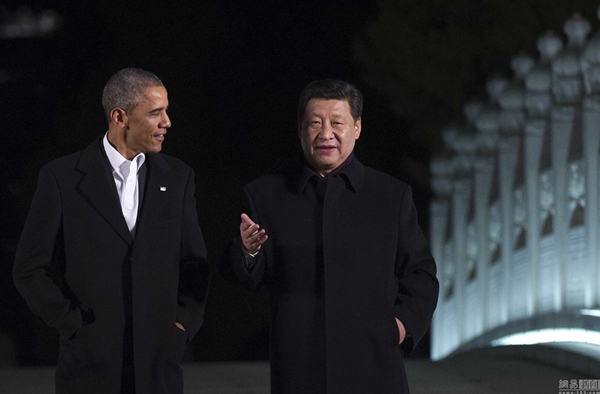Xi's Asia-Pacific blueprint
- By An Gang
 0 Comment(s)
0 Comment(s) Print
Print E-mail China.org.cn, March 11, 2015
E-mail China.org.cn, March 11, 2015
|
President Xi Jinping and US President Barack Obama go on a stroll in Zhongnanhai, the area of Beijing known as the heart of the government, on Tuesday evening, Nov 11, 2014.[Photo/Xinhua] |
Bridging China and the US
China's rising influence in the Asia-Pacific region will unavoidably clash with the interests of the United States. In response to China's rapid rise, U.S. President Barack Obama unveiled a "pivot to Asia" strategy in his first term, which caused a certain degree of misunderstanding between China and the United States. President Obama has since attempted to tone down the rhetoric in his second term to ease Beijing's concerns. Shortly after John Kerry assumed the post as U.S. Secretary of State in April 2013, he paid a visit to Asia. In Beijing, Kerry said the United States could contribute to the realization of the Chinese dream. And in a speech in Tokyo, Kerry designed and defined the U.S. version of the Pacific dream as "one in which nations and people forge a partnership that shapes our shared future" based on "an unprecedented security, economic, and social cooperation."
The Pacific dream concept has since rarely been repeated by high-ranking U.S. officials; however, the Obama administration has not let up in promoting its "pivot to Asia" strategy. The United States attaches great importance to China-U.S. relations and sees China as an important partner in many fields such as economy and trade, regional conflicts and climate change, but the goal of its Asia-Pacific policy is to maintain U.S. leadership in the region—a stance that inevitably poses competition with China. For instance, China was ruled out of the U.S.-led Trans-Pacific Partnership negotiation but has made strides in forming a larger free trade agreement in the Asia-Pacific. In the South China Sea, China is on high alert for U.S. intentions to publicly get involved in the maritime disputes.
The focus of global economic development is rapidly moving to the Asia-Pacific. The respective dreams of the world's two largest economies are set to meet in the Pacific Ocean, and their subsequent interaction will impact the future of the region and even the whole world. If China and the United States lean toward confrontation in the region, other nations may be forced to take sides—potentially creating a new Cold War situation that could seriously disrupt regional development.
Only when the two countries create long-term stability and prosperity in the region through fair competition and cooperation can they realize an Asia-Pacific dream belonging to all regional members. President Xi's scheduled visit to the United States this September is expected to further enhance the friendly cooperation between the two nations. The major obstacle standing in their way is strategic distrust, which is evidenced by the faulty mentalities that push the "China threat" and "U.S. conspiracy" narratives in the respective countries. Persistent strategic dialogue and mutually beneficial cooperation between the two governments are the clearest paths to long-lasting peace and development in the Asia-Pacific.
The author is an op-ed contributor to Beijing Review.
Source: Beijing Review






